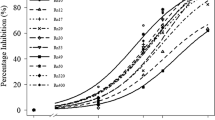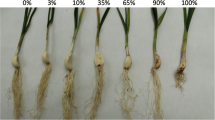Abstract
Vanda is a highly valued and important orchid in the horticultural industry; however, it is usually damaged by black rot disease, caused by Phytophthora species, leading to substantial economic losses. This study aims to evaluate multiple fungicides for black rot control. Oomycetes were isolated from diseased plants, and these isolates brought about a 100% disease incidence in Vanda with water-soaked lesions, becoming necrotic within 24 h. The isolates were identified as Phytophthora palmivora based on a phylogenetic analysis of internal transcribed spacers (ITSs) and cytochrome oxidase spacer regions. For controlling black rot disease, eight fungicides or mixtures with different target sites and modes of action were screened, including cyazofamid, dimethomorph, fosetyl-aluminum, metalaxyl, thiophanate-methyl, a mixture of fluopicolide and fosetyl-aluminum, a mixture of mancozeb and valifenalate, and a mixture of quintozene and etridiazole. All tested fungicides showed 33%–100% growth inhibition using the poisoned food technique. In greenhouse experiments, seven tested fungicide formulations, except for thiophanate-methyl, exhibited 20%–66% reduced lesion sizes compared with the no-chemical control. The information on fungicides with different filicide group codes could assist a fungicide spray program for black rot management in orchids.








Similar content being viewed by others
Data Availability
Sequence data of this study have been deposited to the GenBank with the accession numbers of PP064980–PP064986 and PP066271–PP066277.
References
Alizadeh, A., & Tsao, P. H. (1985). Effect of light on sporangium formation, morphology, ontogeny, and caducity of Phytophthora capsici and P. palmivora MF4 isolates from black pepper and other hosts. Transactions of the British Mycological Society, 85(1), 47–69. https://doi.org/10.1016/S0007-1536(85)80155-8
Bag, T. K., Dutta, P., Hubballi, M., Kaur, R., Mahanta, M., Chakraborty, A., Das, G., Kataky, M., & Wonghonde, R. (2024). Destructive Phytophthora on orchids: Current knowledge and future perspectives. Frontier in Microbiology, 14, 1139811. https://doi.org/10.3389/fmicb.2023.1139811
Bose, T., & Hammerbacher, A. (2023). The first report of Phytophthora multivesiculata causing black rot of Cymbidium and Ansellia africana from South Africa. Plant Disease, 107(2), 588. https://doi.org/10.1094/PDIS-03-22-0623-PDN
Bouckaert, R., Vaughan, T. G., Barido-Sottani, J., Duchêne, S., Fourment, M., Gavryushkina, A., et al. (2019). BEAST 2.5: An advanced software platform for Bayesian evolutionary analysis. PLOS Computational Biology, 15(4), e1006650. https://doi.org/10.1371/journal.pcbi.1006650
Caldiz, D. O., Rolon, D. A., Di Rico, J., & Andreu, A. B. (2007). Performance of dimethomorph+ mancozeb applied to seed potatoes in early management of late blight (Phytophthora infestans). Potato Research, 50(1), 59–70. https://doi.org/10.1007/s11540-007-9029-2
Cating, R. A., Palmateer, A. J., Stiles, C. M., Rayside, P. A., & Davison, D. A. (2009). Black rot of orchids caused by Phytophthora palmivora and Phytophthora cactorum. EDIS, 2009(2), 1. https://doi.org/10.32473/edis-pp260-2009
Department of International Trade Promotion. (2023). Orchid products. Retrieved December 19, 2023, from https://www.ditp.go.th/post/75877
Drenth, A., & Sendall, B. (2004). Isolation of Phytophthora from infected plant tissue and soil, and principles of species identification. In A. Drenth & D. I. Guest (Eds.), Diversity and management of Phytophthora in Southeast Asia (pp. 94–102). Australian Centre for International Agricultural Research.
Edgar, R. C. (2004). MUSCLE: Multiple sequence alignment with high accuracy and high throughput. Nucleic Acids Research, 32(5), 1792–1797. https://doi.org/10.1093/nar/gkh340
Fungicide Resistance Action Committee. (2023). FRAC code list 2023. Fungal control agents sorted by cross-resistance pattern and mode of action. Retrieved December 20, 2023, from https://www.frac.info/docs/default-source/publications/frac-code-list/frac-code-list-2023---final.pdf
Gouy, M., Guindon, S., & Gascuel, O. (2010). SeaView version 4: A multiplatform graphical user interface for sequence alignment and phylogenetic tree building. Molecular Biology and Evolution, 27(2), 221–224. https://doi.org/10.1093/molbev/msp259
Grünwald, N. J., Martin, F. N., Larsen, M. M., Sullivan, C. M., Press, C. M., Coffey, M. D., Hansen, E. M., & Parke, J. L. (2011). Phytophthora-ID.org: A sequence-based Phytophthora identification tool. Plant Disease, 95(3), 337–342. https://doi.org/10.1094/PDIS-08-10-0609
Jackson, K. L., Yin, J., Csinos, A. S., & Ji, P. (2010). Fungicidal activity of fluopicolide for suppression of Phytophthora capsici on squash. Crop Protection, 29(12), 1421–1427. https://doi.org/10.1016/j.cropro.2010.08.001
Jackson, K. L., Yin, J., & Ji, P. (2012). Sensitivity of Phytophthora capsici on vegetable crops in Georgia to mandipropamid, dimethomorph, and cyazofamid. Plant Disease, 96(9), 1337–1342. https://doi.org/10.1094/PDIS-12-11-1082-RE
Judelson, H. S., & Ah-Fong, A. M. V. (2019). Exchanges at the plant-oomycete interface that influence disease. Plant Physiology, 179(4), 1198–1211. https://doi.org/10.1104/pp.18.00979
Leesutthiphonchai, W., & Judelson, H. S. (2019). Phytophthora infestans sporangia produced in artificial media and plant lesions have subtly divergent transcription profiles but equivalent infection potential and aggressiveness. Molecular Plant-Microbe Interactions, 32(9), 1077–1087. https://doi.org/10.1094/MPMI-12-18-0349-TA
Lewis Ivey, M. L. (2022). Developing an effective fungicide spray program for grapes in Ohio-2022. Plant pathology series No. 147. Retrieved July 9, 2023, from https://cpb-us-w2.wpmucdn.com/u.osu.edu/dist/b/28945/files/2022/01/2022Grape-Fungicide-Spray-Guide-FINAL.pdf
Matson, M. E., Small, I. M., Fry, W. E., & Judelson, H. S. (2015). Metalaxyl resistance in Phytophthora infestans: Assessing role of RPA190 gene and diversity within clonal lineages. Phytopathology, 105(12), 1594–1600. https://doi.org/10.1094/PHYTO-05-15-0129-R
McMillan, R. T., Palmateer, A., & Cating, R. A. (2009). Problems in controlling Phytophthora cactorum on cattleya orchids. Proceedings of the Florida State Horticultural Society, 122, 426–428.
Michels, L., Bronkhorst, J., Kasteel, M., De Jong, D., Albada, B., Ketelaar, T., Govers, F., & Sprakel, J. (2022). Molecular sensors reveal the mechano-chemical response of Phytophthora infestans walls and membranes to mechanical and chemical stress. Cell Surface, 8, 100071. https://doi.org/10.1016/j.tcsw.2021.100071
Orlikowski, L. B., & Szkuta, G. (2006). Phytophthora rot of some orchids-new disease in Poland. Phytopathologia Polonica, 40, 57–61.
Park, B., Martin, F., Geiser, D. M., Kim, H. S., Mansfield, M. A., Nikolaeva, E., Park, S. Y., Coffey, M. D., Russo, J., Kim, S. H., Balci, Y., Abad, G., Burgess, T., Grünwald, N. J., Cheong, K., Choi, J., Lee, Y. H., & Kang, S. (2013). Phytophthora database 2.0: Update and future direction. Phytopathology, 103(12), 1204–1208. https://doi.org/10.1094/PHYTO-01-13-0023-R
Statistics kingdom. (2017). One-Way ANOVA Calculator and Tukey HSD. Retrieved July 12, 2023, from https://www.statskingdom.com/180Anova1way.html
Tao, Y. H., Ho, H. H., Wu, Y. X., & He, Y. Q. (2011). Phytophthora nicotianae causing Dendrobium Blight in Yunnan Province, China. International Journal of Plant Pathology, 2(4), 177–186. https://doi.org/10.3923/ijpp.2011.177.186
Thammasiri, K. (2016). Thai orchid genetic resources and their improvement. Horticulturae, 2(3), 9. https://doi.org/10.3390/horticulturae2030009
Thomidis, T., & Michailidis, Z. (2002). Preliminary evaluation of nine fungicides for control of Phytophthora cactorum and P. citrophthora associated with crown rot in peach trees. Phytoparasitica, 30(1), 52–60. https://doi.org/10.1007/BF02983970
Uchida, J. Y. (1994). Diseases of orchids in Hawaii. Plant Disease, 78(3), 220–224. https://doi.org/10.1094/PD-78-0220
Vasavada, N. (2016). One-way ANOVA (analysis of variance) with post-hoc Tukey HSD (Honestly Significant Difference) Test Calculator for comparing multiple treatments. Retrieved July 12, 2023, from https://astatsa.com/OneWay_Anova_with_TukeyHSD/
Wongwan, T., Haituk, S., Senwanna, S., To-Anun, C., Intaparn, P., & Cheewangkoon, R. (2021). New Host Record of Phytophthora palmivora Causing Black Rot on Rhynchostylis gigantea in Thailand. Chiang Mai Journal of Science, 48(3), 942–951, from http://cmuir.cmu.ac.th/jspui/handle/6653943832/75782. Accessed 23 Aug 2023.
Xiang, Q., & Judelson, H. S. (2014). Myb transcription factors and light regulate sporulation in the oomycete Phytophthora infestans. PLoS One, 9(4), e92086. https://doi.org/10.1371/journal.pone.0092086
Zelaya-Molina, L. X., Ortega, M. A., & Dorrance, A. E. (2011). Easy and efficient protocol for oomycete DNA extraction suitable for population genetic analysis. Biotechnology Letters, 33(4), 715–720. https://doi.org/10.1007/s10529-010-0478-3
Acknowledgements
This study was financially supported by the Kasetsart University Research and Development Institute (KURDI), Bangkok, Thailand. The authors also thank the KURDI for English editing and writing assistance.
Author information
Authors and Affiliations
Corresponding author
Ethics declarations
Competing interests
The authors have no competing interests to declare.
Rights and permissions
Springer Nature or its licensor (e.g. a society or other partner) holds exclusive rights to this article under a publishing agreement with the author(s) or other rightsholder(s); author self-archiving of the accepted manuscript version of this article is solely governed by the terms of such publishing agreement and applicable law.
About this article
Cite this article
Piasai, O., Anyong, T., Khewkhom, N. et al. Fungicides control black rot in Vanda: a strategy to avoid fungicide resistance. Eur J Plant Pathol (2024). https://doi.org/10.1007/s10658-024-02824-1
Accepted:
Published:
DOI: https://doi.org/10.1007/s10658-024-02824-1




